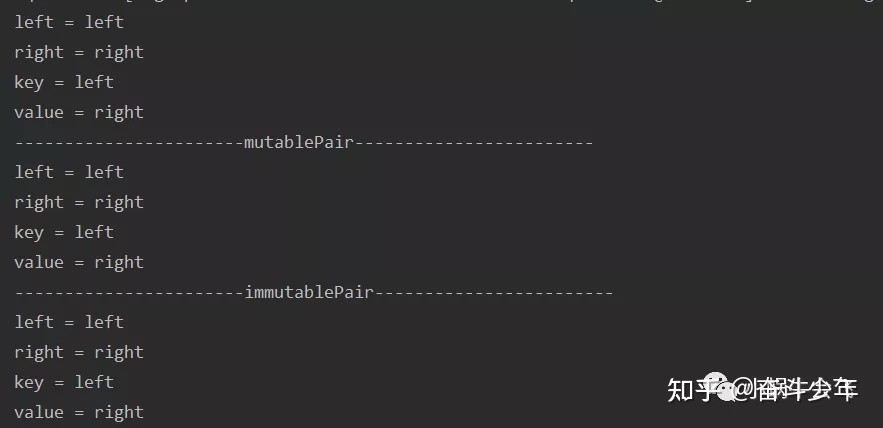Java中的Pair详细
前言:
Java中的Pair在开发的过程中,无意中发现项目中有用到Pair,对于我之前从来没有遇到过这个东西,觉得这个东西挺有意思,所以就记录下。
在我们写代码的时候,肯定会遇到要返回两个值,但是这两个值都有用到,所以我们一般都会用map集合进行key-value封装,或者写一个类来封装两个属性来返回,但是这两种方式虽然实现起来简单,但是感觉有点浪费类或者不美观,如果大量的出现这种,就大量创建类或者map集合。为了解决这问题,强大的工具类-pair,这个类是在org.apache.commons.lang3.tuple包下的。
1 Pair用法
我们先来看看Pair用法:
@Test
public void TestPair() {
Pair<String,String> pair = Pair.of("left","right");
System.out.println("left = " + pair.getLeft());
System.out.println("right = " + pair.getRight());
System.out.println("key = " + pair.getKey());
System.out.println("value = " + pair.getValue());
Pair<String,String> mutablePair = new MutablePair<>("left","right");
System.out.println("-----------------------mutablePair------------------------");
System.out.println("left = " + pair.getLeft());
System.out.println("right = " + pair.getRight());
System.out.println("key = " + pair.getKey());
System.out.println("value = " + pair.getValue());
Pair<String,String> immutablePair = new ImmutablePair<>("left","right");
System.out.println("-----------------------immutablePair------------------------");
System.out.println("left = " + pair.getLeft());
System.out.println("right = " + pair.getRight());
System.out.println("key = " + pair.getKey());
System.out.println("value = " + pair.getValue());
}
上面是比较简单的列子,下面我们看下打印的结果:

上面就是打印的结果,其中MutablePair,ImmutablePair是pair的子类,这样子就很方便的使用,不需要另外定义map集合和类来封装了。
2 Pair源码
其实源码也是算比较简单的,Pair源码如下:
//
// Source code recreated from a .class file by IntelliJ IDEA
// (powered by Fernflower decompiler)
//
package org.apache.commons.lang3.tuple;
import java.io.Serializable;
import java.util.Objects;
import java.util.Map.Entry;
import org.apache.commons.lang3.builder.CompareToBuilder;
public abstract class Pair<L, R> implements Entry<L, R>, Comparable<Pair<L, R>>, Serializable {
private static final long serialVersionUID = 4954918890077093841L;
public Pair() {
}
// 默认用的是子类ImmutablePair,
public static <L, R> Pair<L, R> of(L left, R right) {
return new ImmutablePair(left, right);
}
// 定义了抽象方法,目的子类去实现
public abstract L getLeft();
// 定义了抽象方法,目的子类去实现
public abstract R getRight();
// 这里的获取key其实就是获取getLeft()方法的值
public final L getKey() {
return this.getLeft();
}
// 这里的获取value 其实就是获取getRight()方法的值
public R getValue() {
return this.getRight();
}
// 这里就是比较两个Pair
public int compareTo(Pair<L, R> other) {
return (new CompareToBuilder()).append(this.getLeft(), other.getLeft()).append(this.getRight(), other.getRight()).toComparison();
}
public boolean equals(Object obj) {
if (obj == this) {
return true;
} else if (!(obj instanceof Entry)) {
return false;
} else {
Entry<?, ?> other = (Entry)obj;
return Objects.equals(this.getKey(), other.getKey()) && Objects.equals(this.getValue(), other.getValue());
}
}
public int hashCode() {
return (this.getKey() == null ? 0 : this.getKey().hashCode()) ^ (this.getValue() == null ? 0 : this.getValue().hashCode());
}
public String toString() {
return "(" + this.getLeft() + ',' + this.getRight() + ')';
}
public String toString(String format) {
return String.format(format, this.getLeft(), this.getRight());
}
}
上面的源码就是简单的定义了我们常规的方法,getLeft()和getRight()方法留给子类去实现,父类默认采用的是ImmutablePair子类,Pair还实现了Entry<L,R>,可以使用getKey()和getValue() ,其实它们都是调用了getLeft()和getRight()方法,继承了Comparable,可以比较两个Pair。继承了Serializable,可以被序列化。
3 ImmutablePair源码
我们看看ImmutablePair源码:
//
// Source code recreated from a .class file by IntelliJ IDEA
// (powered by Fernflower decompiler)
//
package org.apache.commons.lang3.tuple;
// 继承了Pair
public final class ImmutablePair<L, R> extends Pair<L, R> {
private static final ImmutablePair NULL = of((Object)null, (Object)null);
private static final long serialVersionUID = 4954918890077093841L;
// 这里用了final修饰,代表的left值设值之后是不可变
public final L left;
// 这里用了final修饰,代表的right值设值之后是不可变
public final R right;
public static <L, R> ImmutablePair<L, R> nullPair() {
return NULL;
}
public static <L, R> ImmutablePair<L, R> of(L left, R right) {
return new ImmutablePair(left, right);
}
public ImmutablePair(L left, R right) {
this.left = left;
this.right = right;
}
public L getLeft() {
return this.left;
}
public R getRight() {
return this.right;
}
// 因为是不可变的值,所以如果set值的话直接抛异常
public R setValue(R value) {
throw new UnsupportedOperationException();
}
}
ImmutablePair源码很简答,只是变量加了final修饰,是不可变的,所以在调用setValue()方法时,就会抛出异常:UnsupportedOperationException。
4 MutablePair源码
MutablePair源码如下:
//
// Source code recreated from a .class file by IntelliJ IDEA
// (powered by Fernflower decompiler)
//
package org.apache.commons.lang3.tuple;
public class MutablePair<L, R> extends Pair<L, R> {
private static final long serialVersionUID = 4954918890077093841L;
public L left;
public R right;
public static <L, R> MutablePair<L, R> of(L left, R right) {
return new MutablePair(left, right);
}
public MutablePair() {
}
public MutablePair(L left, R right) {
this.left = left;
this.right = right;
}
public L getLeft() {
return this.left;
}
public void setLeft(L left) {
this.left = left;
}
public R getRight() {
return this.right;
}
public void setRight(R right) {
this.right = right;
}
// 这里set value值,会返回旧value值
public R setValue(R value) {
R result = this.getRight();
this.setRight(value);
return result;
}
}
上面的MutablePair源码跟ImmutablePair源码不同之处就是MutablePair可变,ImmutablePair不可变。
5 疑问?
如果要求返参不止2个,3个怎么办???
没问题,一样满足你,在这个org.apache.commons.lang3.tuple包中提供了针对构建三个元素的Triple类,类定义中abstract class Triple<L, M, R>。定义了3个泛型同样提供了ImmutableTriple和MutableTriple一对不可变和可变的实现类,源码跟上面的差不多,只是多加了个变量属性而已。
那如果4个范参,5个范参呢,那不好好意思,你只能通过定义bean封装返回,或者map集合返回。
你知道的越多,你不知道的越多!我们下期再见!
到此这篇关于Java中的Pair详细的文章就介绍到这了,更多相关Java中的Pair内容请搜索猪先飞以前的文章或继续浏览下面的相关文章希望大家以后多多支持猪先飞!
相关文章
- 这篇文章主要介绍了如何利用java语言实现经典《复杂迷宫》游戏,文中采用了swing技术进行了界面化处理,感兴趣的小伙伴可以动手试一试...2022-02-01
java 运行报错has been compiled by a more recent version of the Java Runtime
java 运行报错has been compiled by a more recent version of the Java Runtime (class file version 54.0)...2021-04-01- 这篇文章主要介绍了在java中获取List集合中最大的日期时间操作,具有很好的参考价值,希望对大家有所帮助。一起跟随小编过来看看吧...2020-08-15
- 这篇文章主要介绍了教你怎么用Java获取国家法定节假日,文中有非常详细的代码示例,对正在学习java的小伙伴们有非常好的帮助,需要的朋友可以参考下...2021-04-23
- 这篇文章主要介绍了Java如何发起http请求的实现,文中通过示例代码介绍的非常详细,对大家的学习或者工作具有一定的参考学习价值,需要的朋友们下面随着小编来一起学习学习吧...2021-03-31
- 说起C#和Java这两门语言(语法,数据类型 等),个人以为,大概有90%以上的相似,甚至可以认为几乎一样。但是在工作中,我也发现了一些细微的差别...2020-06-25
- 这篇文章主要介绍了解决Java处理HTTP请求超时的问题,具有很好的参考价值,希望对大家有所帮助。一起跟随小编过来看看吧...2021-03-29
- 这篇文章主要介绍了java 判断两个时间段是否重叠的案例,具有很好的参考价值,希望对大家有所帮助。一起跟随小编过来看看吧...2020-08-15
- 这篇文章主要介绍了超简洁java实现双色球若干注随机号码生成(实例代码),本文通过实例代码给大家介绍的非常详细,对大家的学习或工作具有一定的参考借鉴价值,需要的朋友可以参考下...2021-04-02
java 画pdf用itext调整表格宽度、自定义各个列宽的方法
这篇文章主要介绍了java 画pdf用itext调整表格宽度、自定义各个列宽的方法,具有很好的参考价值,希望对大家有所帮助。一起跟随小编过来看看吧...2021-01-31- 这篇文章主要介绍了Java生成随机姓名、性别和年龄的实现示例,文中通过示例代码介绍的非常详细,对大家的学习或者工作具有一定的参考学习价值,需要的朋友们下面随着小编来一起学习学习吧...2020-10-01
- 这篇文章主要介绍了java正则表达式判断前端参数修改表中另一个字段的值,需要的朋友可以参考下...2021-05-07
Java使用ScriptEngine动态执行代码(附Java几种动态执行代码比较)
这篇文章主要介绍了Java使用ScriptEngine动态执行代码,并且分享Java几种动态执行代码比较,需要的朋友可以参考下...2021-04-15- 这篇文章主要介绍了Java开发实现人机猜拳游戏,文中示例代码介绍的非常详细,具有一定的参考价值,感兴趣的小伙伴们可以参考一下...2020-08-03
- 这篇文章主要介绍了Java List集合返回值去掉中括号('[ ]')的操作,具有很好的参考价值,希望对大家有所帮助。一起跟随小编过来看看吧...2020-08-29
Java中lombok的@Builder注解的解析与简单使用详解
这篇文章主要介绍了Java中lombok的@Builder注解的解析与简单使用,本文给大家介绍的非常详细,对大家的学习或工作具有一定的参考借鉴价值,需要的朋友可以参考下...2021-01-06- 下面小编就为大家带来一篇java中String类型变量的赋值问题介绍。小编觉得挺不错的。现在分享给大家,给大家一个参考。...2016-03-28
Java 8 Stream 的终极技巧——Collectors 功能与操作方法详解
这篇文章主要介绍了Java 8 Stream Collectors 功能与操作方法,结合实例形式详细分析了Java 8 Stream Collectors 功能、操作方法及相关注意事项,需要的朋友可以参考下...2020-05-20- 这篇文章主要介绍了Java线程池中的各个参数如何合理设置操作,具有很好的参考价值,希望对大家有所帮助。如有错误或未考虑完全的地方,望不吝赐教...2021-06-19
- 这篇文章主要介绍了C++ pair的用法实例详解的相关资料,需要的朋友可以参考下...2020-04-25
